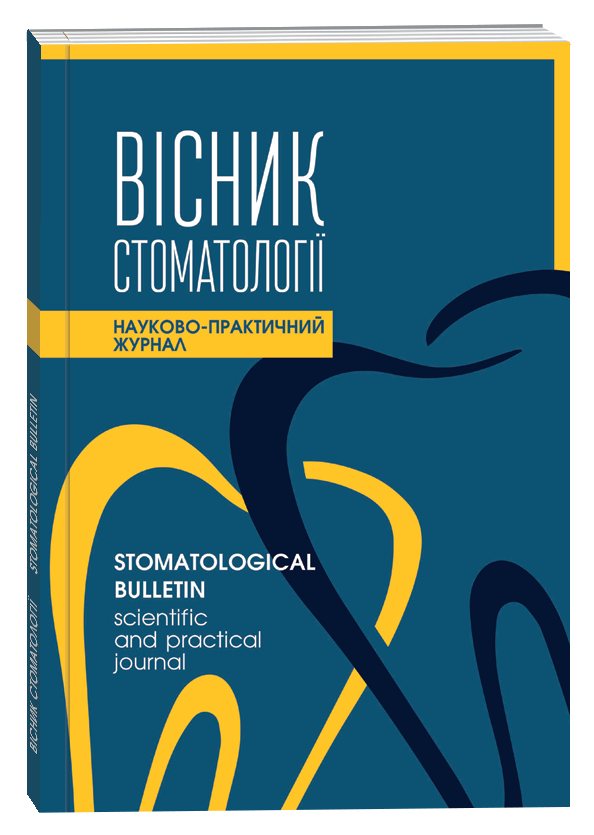CORRELATION BETWEEN CARIES INTENSITY AND DENTAL CARIES FACTORS
DOI:
https://doi.org/10.35220/2078-8916-2022-44-2.20Keywords:
caries intensity, cariesogenic factors, Pearson correlation coefficientAbstract
Purpose of the work. To study the dependence (correlation) between the intensity of caries and the factors of the cariogenic situation: intensity of dental deposits (hygiene index), functional activity of salivary glands (salivation rate) and enamel resistance (acid solubility – TER-test) in students aged 19 to 21 years Materials and methods. Clinical studies were conducted with the participation of 22 students. Individual indicators of caries intensity and indicators reflecting the cariogenic situation were studied. Correlation analysis is a way of assessing linear relationships (general proportionality) between variables, that is, how coherently they change. The Pearson correlation coefficient was used in the work. The Pearson correlation (usually just "correlation") between variables can be positive, negative, or absent at all. Two variables are positively correlated if large values of one variable tend to be associated with larger values of the other variable. If large values of one variable are associated with smaller values of another variable, there is a negative correlation. In the absence of correlation, there is no regularity in the relationship of some indicators with others. Results of researches.Studies have shown that the correlation indices of all compared values are high (approaching 1 – absolute positive or negative correlation). The highest correlation of caries intensity was observed with the hygiene index (0.9135), then with the TER test (0.8974), and with the rate of salivation (-0.8471).
References
Прогностична модель виникнення раннього запалення в тканинах пародонта в пацієнтів з ортодонтичними конструкціями за біохімічними показниками ротової рідини. / І. В. Ковач, О. В. Копчак, К. А. Бунятян, Л. В. Крячкова, Н. В. Алєксєєнко, О. Ю. Біндюгін. Мед.перспективи. 2022. № 1. С. 145-151.
O. S. Volkova. Analysis of changes in biochemical parameters of oral liquid under the influence of lecithincalcium
complex in young patients with multiple caries. Запорожський медичний журнал. 2018. № 3. С. 375-378.
Siqueira State and Challenges of the Global Outcomes of Dental Caries Research in the Meta-Omics Era / Dina G. Moussa, Ahmad Paras, Tamer A. Mansour, Walter L. Current. Front Cell Infect Microbiol. 2022. 12. 887907. URL: https://doi: 10.3389/fcimb.2022.887907PM CID: PMC9247192.
Dental caries in primary and permanent teeth in children’s worldwide, 1995 to 2019: a systematic review and meta-analysis. / Mohsen Kazeminia, Alireza Abdi, Shamarina Shohaimi, Rostam Jalali, Aliakbar Vaisi-Raygani, Nader Salari, Masoud Mohammadi. Head Face Med. 2020. 16-22 URL: https://doi: 10.1186/s13005-020-00237-zPMCID: PMC7541284.
Взаємозв'язок захворюваності на карієс тимчасових зубів із патологією опорно-рухового апарату в дітей дошкільного віку з урахуванням біохімічних маркерів метаболізму сполучної тканини. / Н. І. Боднарук, Н. І. Смоляр, Н. Л. Чухрай, О. О. Машкаринець, І. В. Ган. Мед.перспективи . 2022. 27, № 2. С. 138-145.
Скульская С. В. Клиническая оценка стоматологического статуса 7-летних детей г. Белая Церковь, проживающих в зоне повышенной антропогенной нагрузки в процессе проведения лечебно-профилактических мероприятий. Вісн. стоматології. 2020. № 4. С. 38-42.
Стан тканин порожнини рота в пацієнтів на цукровий діабет 2 типу. / С. А. Шнайдер, В. Я. Скиба, О. В. Скиба, Г. О. Бабеня, С. Д. Варжапетян. Мед. Перспективы. 2020. 25, № 3. С. 153-160.
Prevalence and intensity study of dental caries in children with bronchial asthma = Исследование распространенности и интенсивности кариеса у детей с бронхиальной астмой / O. V. Voznyi, T. Ye. Shumna, Ye. S. Lepetchenko. Запорож.мед.журнал. 2020. 22, № 3. С. 384-388.
Associations between dental caries and systemic diseases: a scoping review. / Sabharwa Amarpreet, Stellrecht Elizabeth, Scannapieco Frank A. BMC Oral Health. 2021. 21. 472. URL: https://doi: 10.1186/s12903-021-01803-w PMCID: PMC8466895.
Dietary free sugar and dental caries in children: A systematic review on longitudinal studies. / Mahboobi Zeinab, Pakdaman Afsaneh, YazdaniReza, Azadbakht Leila, Montazer Ali. Health Promot Perspect. 2021. 11(3). 271–280 URL: https://doi: 10.34172/hpp.2021.35 PMCID: PMC8501477.
Artificial Saliva for Therapeutic Management of Xerostomia: A Narrative Review. / Alhejoury Hajer Ayed, Mogharbel Lina Fouad et al. J Pharm Bioallied Sci. 2021. Suppl 2. S. 903–907. URL: https://doi: 10.4103/jpbs.jpbs_236_21.
Иванов В.С. Заболевания пародонта. – 3-е изд., перераб. и доп. М.: Мед. информ. агентство, 1998. 296 с.
Леонтьев В.К., Петрович Ю.А. Биохимические методы исследования в клинической и экспериментальной стоматологии. Методическое пособие. Омск, 1976. 95 с.
Окушко В.Р. Клиническая физиология эмали зуба. К.: Здоров’я, 1984. С.64.
Онлайн калькулятор: Коэффициент корреляции Пирсона. URL: http://www.planetcalc.ru/527/









